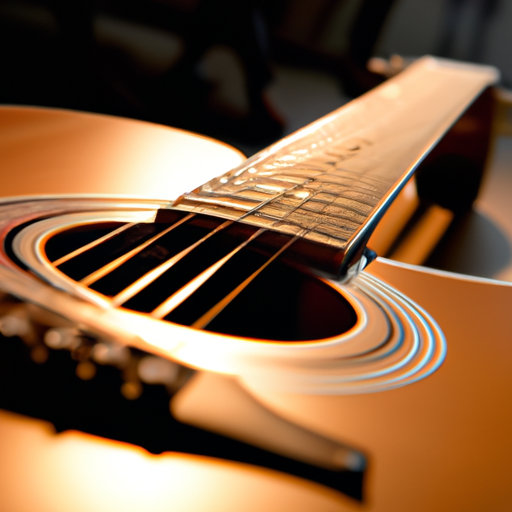
Choosing the right guitar is crucial for any musician, whether you are a beginner or an advanced player. The perfect guitar can greatly enhance your playing experience and help you achieve the desired sound. In this article, we will guide you through the process of selecting the ideal guitar for your needs.

Playing the guitar is a popular and enjoyable hobby for many people. However, it is important to choose the right guitar that matches your style, skill level, and budget. This article will provide you with valuable insights and tips to help you make an informed decision.

Before purchasing a guitar, it is important to identify your playing style. Different music genres require different guitar styles. Whether you are into rock, blues, classical, or country music, there is a guitar that suits your playing style.
Take the time to listen to different genres and pay attention to the type of guitar used in each. You can also seek guidance from experienced guitarists or music teachers to help you determine your preferred playing style.
- Listen to a variety of music genres and pay attention to the sound of the guitar. - Experiment with different playing techniques on a borrowed guitar. - Attend live performances and observe the guitars used by professional musicians. - Take guitar lessons to explore different playing styles.
When choosing a guitar, it is important to consider your skill level. There are guitars specifically designed for beginners, intermediate players, and advanced musicians.
Beginner guitars are usually more affordable and easier to play, with features that facilitate learning. Intermediate guitars offer more advanced features and better sound quality, suitable for players who have mastered the basics. Advanced guitars are designed for professional musicians and offer the highest quality sound and craftsmanship.
- Budget: Determine your budget and find a guitar that fits within your price range. - Sound Quality: Consider the sound quality and resonance of the guitar. - Playability: Test the guitar's action and neck profile to ensure it feels comfortable to play. - Durability: Look for a guitar with a solid construction that can withstand frequent playing.
Setting a budget is essential when purchasing a guitar. Guitars come in a wide range of prices, from affordable entry-level models to high-end professional instruments.
While it is tempting to go for the most expensive guitar, it is important to find a balance between your budget and the features you need. Remember that a higher price doesn't always guarantee better quality.
- Entry-Level Guitars: These guitars are suitable for beginners and have basic features and construction. They are often made of laminate wood and are more affordable. - Mid-Range Guitars: These guitars offer better quality and sound, with solid wood construction and more advanced features. They are suitable for intermediate players. - High-End Guitars: Designed for professional musicians, these guitars offer superior craftsmanship, exceptional sound quality, and premium materials.
One of the first decisions you need to make is whether to choose an acoustic or electric guitar. Both types have their own characteristics and advantages.
An acoustic guitar produces sound through its hollow body and doesn't require an amplifier. It is versatile and suitable for various music genres, especially folk, country, and singer-songwriter styles. Electric guitars, on the other hand, require an amplifier and produce sound through pickups. They are ideal for rock, blues, and metal genres, offering a wide range of sounds and effects.
- Consider the music genre you are most interested in playing. - Experiment with both acoustic and electric guitars to determine which suits your style better. - Understand the different sound characteristics and tonal options offered by each type.
Guitar body type and size play a significant role in the sound characteristics and comfort of playing. There are several common body types, including dreadnought, concert, auditorium, and jumbo.
A dreadnought body offers a balanced and powerful sound, suitable for strumming and flat-picking. Concert and auditorium bodies are smaller and provide a more focused sound, ideal for fingerstyle playing. Jumbo bodies produce a rich and loud sound, perfect for aggressive strumming and rhythm playing.
- Consider your physical build and hand size when choosing the guitar size. - Visit a guitar store and try different sizes to find the one that feels comfortable to play. - Consult with a guitar teacher or experienced guitarist for recommendations based on your body type.
The tonewood used in a guitar's construction greatly influences its sound quality and tone. Different tonewoods produce unique characteristics and resonance.
Common tonewoods used for guitar tops include spruce, cedar, mahogany, and maple. Spruce is known for its balanced tone, while cedar offers a warmer and richer sound. Mahogany provides a focused and punchy tone, while maple offers a bright and articulate sound.
- Do research on different tonewoods and their sound characteristics. - Consider the music genre you intend to play and the specific sound you desire. - Test guitars made with different tonewoods to experience their differences firsthand.
The neck profile and scale length of a guitar greatly affect its playability and comfort. Neck profiles come in various shapes, such as C-shaped, V-shaped, and U-shaped. Each profile offers a different feel and grip.
Scale length refers to the length between the nut and the bridge of the guitar. Shorter scale lengths are more suitable for players with smaller hands, while longer scale lengths offer more tension and sustain.
- Test guitars with different neck profiles to find the one that feels comfortable in your hands. - Consider your hand size and playing technique when choosing the scale length. - Seek advice from experienced guitarists or guitar teachers for recommendations.
When purchasing a guitar, it is important to research the brand's reputation and read reviews from other guitarists. Reputable brands usually offer better quality instruments and reliable customer service.
Take the time to explore different brands, their history, and the feedback from users. Online forums and music communities are great resources to gather information and opinions from experienced players.
- Look for established guitar brands with a long history of producing quality instruments. - Read reviews and testimonials from other guitarists to learn about their experiences. - Consider the availability of spare parts and customer support when choosing a brand.
Before making a final decision, it is crucial to test and try out different guitars to ensure they meet your expectations. Testing a guitar in person allows you to assess its sound, playability, and comfort.
Visit local guitar stores and spend time playing different models. Experiment with various playing techniques and styles to get a feel for each guitar's capabilities. Pay attention to the guitar's action, intonation, and overall sound quality.
- Play the guitar both sitting down and standing up to assess its comfort and balance. - Test the guitar's intonation and tuning stability across different frets. - Compare the sound of each guitar by playing the same chords and melodies.
Choosing the perfect guitar requires careful consideration of various factors, including playing style, skill level, budget, body type, tonewood, and brand reputation. It is essential to take the time to try out different guitars and gather as much information as possible.
Remember, the perfect guitar is the one that feels comfortable to play, produces your desired sound, and inspires you to keep playing. So, don't rush the process and enjoy the journey of finding your ideal instrument.
For more information on choosing the perfect guitar, click here.